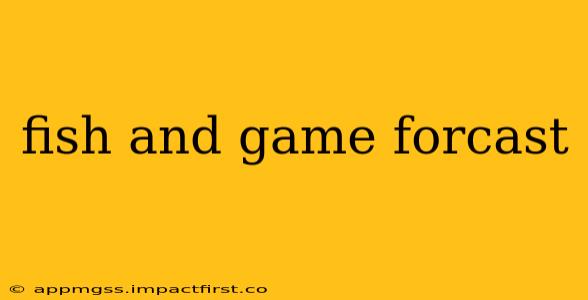Predicting the behavior of fish and game is a complex undertaking, blending scientific understanding with keen observation and a touch of intuition. While a precise forecast guaranteeing a successful fishing or hunting trip is impossible, understanding the factors that influence animal movement and activity allows for informed predictions, maximizing your chances of a rewarding outdoor experience. This guide explores various aspects influencing fish and game populations, helping you make more educated forecasts.
What Factors Influence Fish and Game Populations?
Several interconnected factors significantly impact fish and game populations and their behavior, making accurate forecasting a challenge. These include:
-
Weather Patterns: Temperature, precipitation, wind, and barometric pressure heavily influence animal activity. Extreme weather events can drastically alter habitat conditions, affecting food availability and animal movement. For example, a sudden cold snap can drive fish deeper into the water, while heavy rainfall can flood crucial breeding grounds.
-
Water Levels and Conditions: For aquatic species, water level fluctuations are critical. Low water levels can concentrate fish, making them easier to find, but also making them more vulnerable. Water temperature and clarity also play a significant role in fish behavior and feeding patterns.
-
Seasonal Changes: Migration patterns, breeding seasons, and food availability are all dictated by the time of year. Understanding these seasonal variations is essential for predicting where and when to find specific species. For instance, many game animals migrate in the fall to find suitable wintering grounds.
-
Food Availability: The abundance and type of food sources directly impact animal populations and their distribution. A plentiful food supply can lead to higher population densities, while a scarcity can force animals to move in search of resources. This is particularly true for both fish and game animals.
-
Predation and Competition: Predator-prey dynamics and interspecies competition heavily influence population numbers and distribution. An increase in predator populations can suppress prey numbers, while competition for resources can lead to territorial disputes and shifts in habitat use.
-
Human Activity: Human impacts such as habitat destruction, pollution, and hunting regulations significantly affect fish and game populations. Understanding these pressures and their influence on animal behavior is crucial for effective forecasting.
How Can I Improve My Fish and Game Forecasts?
While perfect prediction remains elusive, here are strategies to improve your chances:
-
Consult Local Experts: Talk to local anglers, hunters, park rangers, and wildlife biologists. Their firsthand knowledge and experience provide invaluable insight into current conditions and typical patterns.
-
Monitor Weather Reports: Pay close attention to weather forecasts, especially concerning temperature, precipitation, and wind. These factors have a direct and immediate impact on animal activity.
-
Track Historical Data: Maintain a personal log of your fishing and hunting experiences, noting the conditions under which you were successful or unsuccessful. This historical data can provide valuable insight into seasonal trends.
-
Utilize Online Resources: Many websites and apps provide fishing and hunting reports, often including information on water levels, fish stocking, and game sightings.
-
Observe Animal Behavior: Spend time in the field observing animal signs such as tracks, scat, and feeding patterns. This firsthand knowledge provides valuable clues about animal activity and distribution.
What are the best sources for fish and game forecasts?
Several sources offer valuable information for enhancing your forecasts. These often include state wildlife agencies, fishing and hunting publications, and specialized weather reports that focus on outdoor conditions. Remember, however, that the accuracy of these forecasts can vary, and local knowledge remains crucial.
How do I interpret fish and game forecasts?
Interpreting fish and game forecasts requires understanding the limitations of prediction. While these forecasts can offer valuable insights, they shouldn't be taken as guarantees. Consider them guidelines to enhance your understanding of potential conditions, informing your decisions but not dictating them.
Are there any apps or websites that provide fish and game forecasts?
Yes, many apps and websites cater to outdoor enthusiasts, offering forecasts and relevant information. However, it's crucial to verify the credibility and accuracy of these sources, considering the specifics of your location and the species you're targeting. The best approach is often to combine information from several trusted sources.
This approach to understanding fish and game populations allows you to make more informed decisions, improving your chances of a successful and enjoyable outdoor adventure. Remember, respect for wildlife and responsible outdoor practices remain paramount, regardless of your forecast's accuracy.
